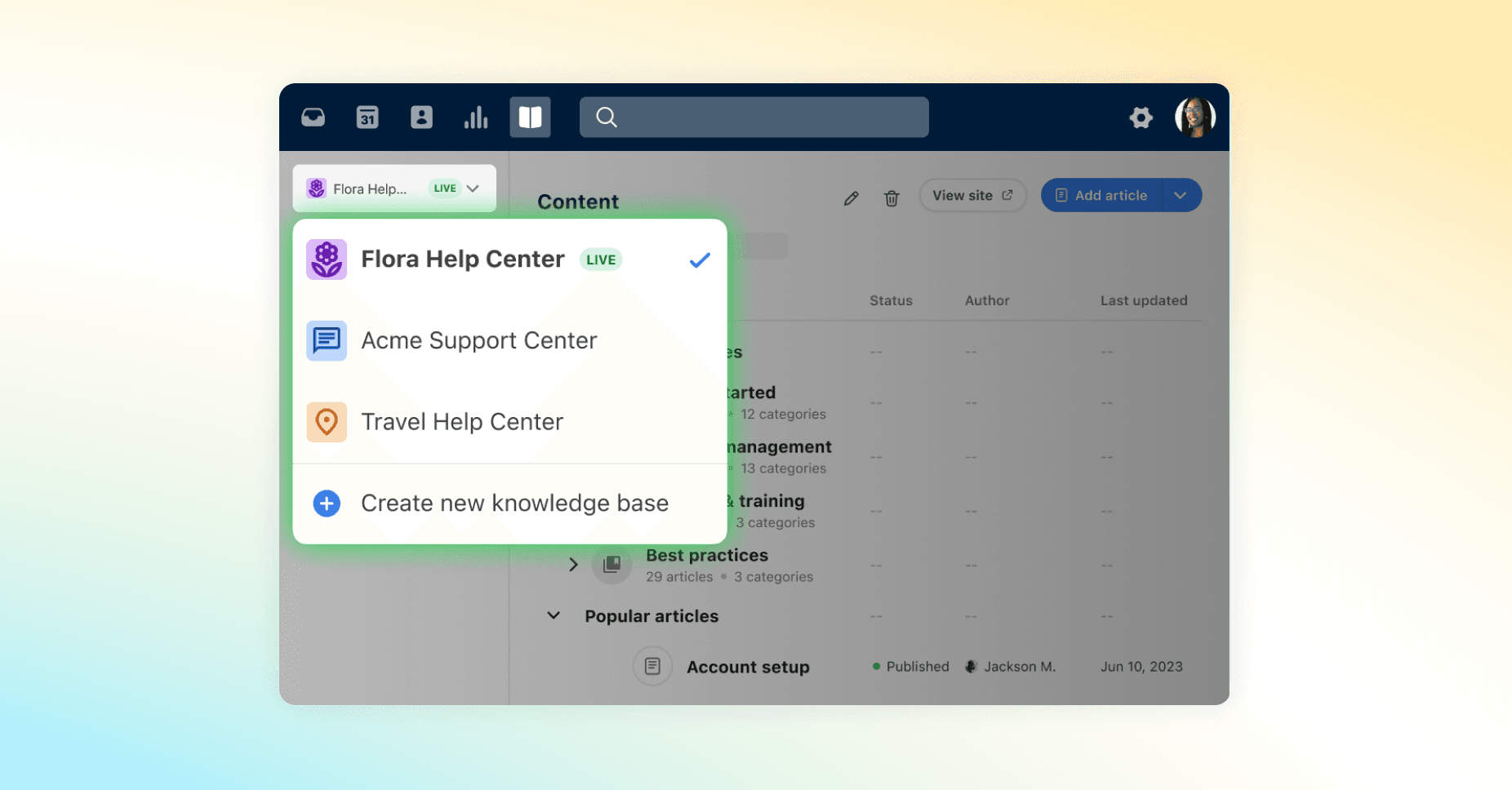It’s 3:00 p.m., and one of your employees is in their third hour trying to find one piece of information a customer needs. Time has been wasted, morale is low, and your customer is still waiting. This isn’t a made-up issue; employees spend an average of 3.6 hours per day just searching for and gathering information.
With an internal knowledge base, situations like these are realities of the past. No more digging through emails, shared drives, or Slack threads to find information. With an internal knowledge base, questions are answered before they’re even asked. Collaboration and success aren’t hindered by the frustrating lack of access to the right resources, and time is reclaimed and channeled into productive tasks.
In this guide, we’ll explore what internal knowledge base software is and how to create one that doesn’t just store information, but transforms the way your team works.
What is an internal knowledge base?
An internal knowledge base is a centralized hub of information that acts as your company’s internal help center. It’s like the digital equivalent of an encyclopedia, storing everything from company policies to product technicalities and project documentation. It’s a place where institutional knowledge is captured, stored, and easily retrieved whenever needed, supporting the success and satisfaction of your team.
Internal knowledge base vs. external knowledge base
An external knowledge base is customer facing, helping users find solutions to their problems without contacting support. An internal knowledge base is designed specifically for employees — it’s the go-to place for team members to search for answers, collaborate, and share insights.
The benefits of an internal knowledge base, however, are felt both internally and externally; an internal knowledge base improves team efficiencies, reduces redundant tasks, and, in turn, drives better results for your customers.
What should you store in an internal knowledge base?
An internal knowledge base should be thoughtfully curated and organized. Here’s a breakdown of the elements that can be included in it:
Company policies and procedures. Your knowledge base should house essential HR policies, operational procedures, and compliance docs. Think employee handbooks, step-by-step guides, and safety protocols — all easily accessible to keep everyone aligned.
Training and onboarding materials. Comprehensive onboarding guides, training manuals, and video tutorials are a must. New hires, like a finance team newbie, need how-to guides and recorded sessions to hit the ground running.
Product and service information. All product and service data — detailed guides, FAQs, sales materials. Sales reps and support agents should find product specs or troubleshooting tips instantly.
Project documentation. Store all project plans, timelines, and updates here. Keep everyone in sync and reduce miscommunication. A project manager can keep the team aligned with this single resource.
Technical support and IT resources. Include IT support guides, software docs, and system diagrams. Make problem-solving quick and efficient without the IT wait.
Department-specific information. Each department should have its own section for key materials — sales playbooks, marketing strategies, finance procedures. Let team members quickly access what they need to excel.
Company news. Feature company announcements, discussion forums, and feedback channels. Keep everyone informed and foster open communication and collaboration.
Retrospectives and lessons learned. Capture and share key insights — case studies, innovative ideas, expert tips. Document successes and inspire creative contributions.
Security and access control guidelines. Include data protection policies, user permissions, and incident response plans. Ensure confidentiality and control access to sensitive info.
Analytics and reporting. Track usage stats, performance metrics, and logs. Use this data to continuously improve your knowledge base and meet your team’s needs.
Remember, the goal is to make as much valuable information as accessible and actionable (in an organized way) as possible, turning your knowledge base into an indispensable resource — an engine, really — for your entire organization.
Benefits of an internal knowledge base
Creating a dynamic, living knowledge base that evolves with your organization has tangible effects. Here’s how an internal knowledge base can be a game-changing tool for your team:
Save time and boosted productivity
Time is money, and an internal knowledge base saves plenty of both. Imagine the productivity boost when your team can find what they need in seconds, rather than minutes or hours. An internal knowledge base reduces the time employees spend searching for information, so they can focus more on important tasks — like helping issues that require deep dives with customers or vetting new tools to streamline their workflows.
Improve collaboration
Strong collaboration looks like everyone having access to the same up-to-date information, no matter their role or department. With features like discussion forums, comments, and shared documents, an internal knowledge base breaks down silos and encourages seamless communication across teams.
Say a product development team is working on a new software feature. The marketing team needs to prepare promotional content, and the customer support team requires training on the new feature to assist customers effectively. An internal knowledge base allows all teams to access the latest project documentation, timelines, and updates in real-time, with shared access keeping everyone on the same page.
Elevate onboarding
An internal knowledge base makes the onboarding process seamless by providing new employees all of the training materials, company policies, and role-specific information they need to get up to speed quickly.
Say a new employee joins the finance department and needs to learn the company’s invoicing process. Instead of relying on one-on-one training sessions (time consuming for both the employee responsible for training and new hire!) the employee can access the internal knowledge base, containing detailed how-to guides, video tutorials, and step-by-step instructions. The new hire can learn at their own pace, referring back to the materials whenever needed.
Facilitate knowledge retention
One of the most significant risks for any organization is the loss of knowledge when employees leave. While you may have had handover processes and attempted to gather all critical information before departure, there’s always a time you can’t predict when you’ll need something and the team member is already gone. An internal knowledge base keeps institutional knowledge captured and retained, reducing the impact of turnover and keeping continuity in business operations.
Steps to create an internal knowledge base
Here’s how to get started in building your own internal knowledge base in six steps that will ensure you hit the primary goals of accuracy, usability, and awareness that make an internal knowledge base successful.
Step 1: Determine your goals
Are you trying to build an internal FAQ, prioritize ease of onboarding, or boost customer service resolution times? Assess your organization’s current knowledge-sharing practices and identify areas for improvement. Whether it’s reducing knowledge gaps, or fostering a culture of continuous learning, specific objectives will guide your efforts and help measure success.
Step 2: Build a knowledge base team
Creating and maintaining a knowledge base requires a dedicated team, including researchers, writers, editors, and administrators, to ensure that the information is accurate, up-to-date, and well-organized.
You can also crowdsource people from various internal teams to own specific sections — like a product manager who can be an editor for their product’s launch materials or a customer success manager who can take charge of monthly audits for customer FAQs.
Step 3: Select the right software
With the right software, your internal knowledge base can quickly fit into your team’s workflow and drive success. Look for a platform that’s easy to use, integrates well with your existing tools, offers customization options, and can automate routine tasks. Front offers all these features, making it an ideal choice for modern organizations.
Step 4: Create and organize content
Content is the heart of your knowledge base, but it’s only as good as it is organized logically. Use templates, consistent formatting, and categorization to ensure easy navigation and retrieval of information. Organize content by departments, topics, or frequently asked questions to make it intuitive for employees to find what they need.
This article shares examples of four Front customers who have built strong knowledge bases with best practices to follow. A few tips from Coastal Reign:
Content format plays a big role in how easily instructions can be followed. Coastal Reign uses sections to break up their categories, so each phase of the ordering process is clearly separated to avoid confusion.
Use category descriptions to supplement the title and icon — making it extra clear to customers what to expect.
Pull out frequently asked questions outside of other categories so customers can see the most common answers at a glance.
Step 5: Implement and launch
Implementing your knowledge base involves careful planning and execution, from setting up the software to training employees on how to use it. If teammates aren’t aware of the resource or educated on how to use it, they won’t see any of the value of your investment.
We recommend a training session for each team and promoting the knowledge base through internal channels to encourage adoption and make it an integral part of your team’s daily workflow. One idea is to offer incentives for early use of the tool.
[h3] Step 6: Maintain it
Once you’ve built your internal knowledge base, you’ll need a system that’s simple yet essential in keeping it relevant and useful. First, set up a regular review schedule. Keep content updated as needed and that outdated information is archived or removed. This keeps your knowledge base accurate and makes it more reliable for your team.
Also, gather and implement employee feedback through surveys, feedback forms, and usage analytics to understand what’s working and what needs improvement. This also helps employees feel invested in its success and get the most out of it.
How Front can help
When your team has quick access to all the right information, they can focus on what really matters: delivering results.
Front is a modern customer service platform that offers a knowledge base as just one piece of the puzzle to delivering stellar service. Front’s knowledge base is integrated within the platform your team uses daily. Whether you’re responding to customer inquiries or collaborating on a project, Front ensures that vital information is always just a click away. Its centralized access, contextual information retrieval, and collaborative editing make it easy to keep your content accurate and up-to-date.
The result? A more efficient, productive, and empowered team.
Ready to transform the way your team works?
Written by Logan Davis
Originally Published: 1 July 2024











